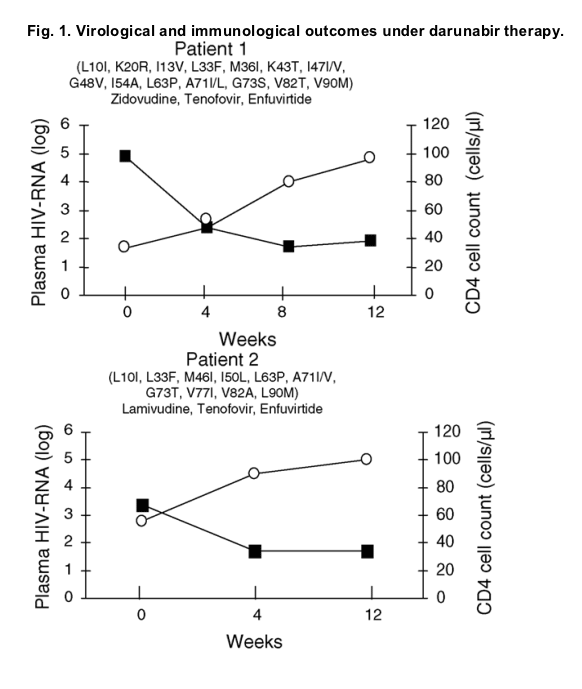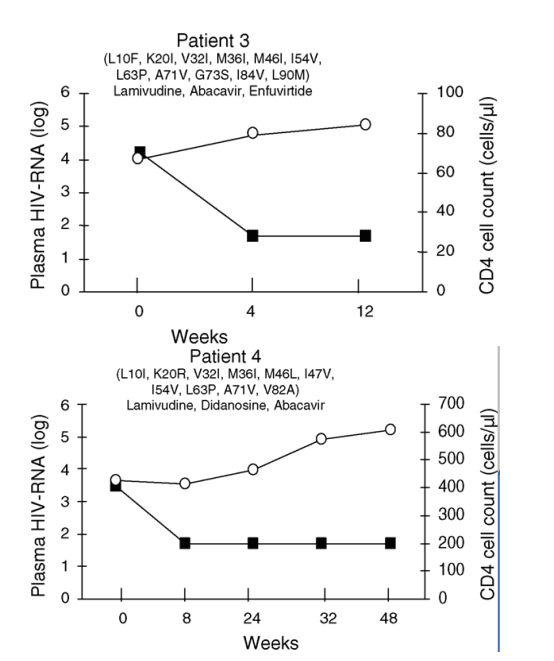| |
Successful rescue therapy with darunabir (TMC114) in HIV-infected patients who have failed several ritonavir-boosted protease inhibitors
|
| |
| |
AIDS: Volume 20(11) 13 July 2006 p 1558-1560
Poveda, Eva; Blanco, Francisco; Garcia-Gasco, Pilar; Alcolea, Antonio; Briz, Veronica; Soriano, Vincent
Abstract
Darunabir, formerly TMC114, is a new protease inhibitor (PI) under clinical development designed to be active against HIV strains resistant to currently available PI. The virological and immunological response to ritonavir-boosted darunabir was assessed in four heavily antiretroviral-experienced patients who had failed enfuvirtide and two or more previous ritonavir-boosted PI regimens, including tipranavir in one instance. All four patients reached undetectable plasma HIV-RNA levels within 8 weeks of therapy and experienced significant CD4 cell count gains.
The growing population of HIV-infected patients harbouring multidrug-resistant viruses highlights the need for new classes of agents for the treatment of HIV infection [1]. Cross-resistance is extensive within protease inhibitors (PI) and the efficacy of ritonavir-boosted PI combinations is greatly influenced by the extent of baseline PI resistance mutations [2]. The accumulation of more than five mutations within the protease gene, including at least one primary mutation, has been associated with poor response to all current available PI [3]. Therefore, the development of new PI with a higher genetic barrier to resistance is crucial. Darunabir, formerly TMC114, is a new PI under clinical development, which has been designed to be active against HIV strains resistant to all currently approved PI [4]. Few data are available regarding the performance of this drug in heavily PI-experienced patients, including those who have failed tipranavir. We describe here the outcome in four heavily antiretroviral-experienced patients who underwent salvage therapy based on darunabir.
Four HIV-infected individuals who had experienced multiples failures to all current classes of antiretroviral agents, including fusion inhibitors, began a rescue therapeutic regimen based on ritonavir-boosted darunabir at doses of 600/100 mg twice a day. All patients had previously failed at least two ritonavir-boosted PI combinations, including lopinavir in all instances and tipranavir in one case.
Plasma HIV-RNA levels were measured at baseline and during darunabir therapy using a commercial assay (branched DNA assay, Versant v3.0; Bayer, Barcelona, Spain), which has a lowest limit of detection of 50 copies/ml. CD4 T-cell counts were determined by flow cytometry (Beckman Coulter Espana, SA, Madrid, Spain) using fluorescein-labelled antibodies.
Genotypic and phenotypic resistance were examined at baseline using plasma samples. Genetic analyses of the pol gene included both HIV-1 reverse transcriptase and protease regions, and were performed using the Viroseq HIV-1 kit (Abbott Laboratories, North Chicago, Illinois, USA) using an automatic sequencer (ABI Prism 3100; Applied Biosystems, Foster City, California, USA). Genetic analyses of the env gene were performed amplifying and sequencing a gp41 fragment that included HR1 and HR2 regions, as described previously [5]. Drug resistance mutations within the pol and env genes were examined following the latest International AIDS Society-USA panel list [6]. Phenotypic analyses for reverse transcriptase and protease inhibitors were performed using Phenosense (Monogram Biosciences, San Francisco, California, USA) [7] and the Virtual/Phenotype assay (Virco, Mechelem, Belgium) [8]. Phenotypic analyses for enfuvirtide were performed using the Phenoscript env assay (ViRalliance SAS, Paris, France) [9,10].
The baseline mean plasma HIV-RNA level was 24 560 copies/ml, ranging from 3033 to 77 000 copies/ml. The mean CD4 cell count was 146 cells/ml, ranging from 33 to 425 cells/ml. Figure 1 shows the genotypic results obtained in the study population before starting darunabir therapy as well as other antiretroviral agents provided along with the drug. As expected, all patients showed multiple drug resistance mutations, which conferred high-level resistance to most currently available antiretroviral agents. Two patients (nos 1 and 2) showed genotypic and phenotypic resistance to all commercially available drugs, including enfuvirtide, darunabir being the only potentially active drug within the salvage regimen. The other two patients received darunabir concomitantly with enfuvirtide (patient no. 3) and three nucleoside analogues (patient no. 4), to which no resistance was found at that time despite being exposed to them in the past. Of note was the fact that all four patients harboured 10 or more PI-associated resistance mutations, including at least two primary changes. Only patient no. 2 was found to be susceptible to tipranavir/ritonavir. Patient no. 1 was already failing on tipranavir/ritonavir before starting darunabir therapy.


In spite of the high degree of baseline drug resistance, all four patients experienced a significant decline in plasma HIV RNA after beginning the rescue regimen based on darunabir, ranging from 1.7 to 2.5 log after 4 weeks of therapy. All individuals reached undetectable viraemia (< 50 HIV-RNA copies/ml) between 4 and 8 weeks after the initiation of darunabir therapy. In parallel, all experienced significant increases in the CD4 cell count, ranging from 60 to 80% of the baseline values. In patient no. 4 the virological and immunological response to darunabir was maintained during 48 weeks of follow-up (Fig. 1).
Recent reports have highlighted the fact that mutations V32I, L33F, I47V and I54L/M are associated with lower susceptibility to darunabir and are selected in patients failing this drug [11]. Of note is the fact that all patients included in our study showed some of these changes at baseline: L33F and I47I/V in patient no. 1; L33F in patient no. 2; V32I in patient no. 3, and V32I and I47V in patient no. 4. In spite of their presence along with multiple other PI-associated resistance changes, a sharp decline in the plasma HIV-RNA level was found in all cases.
All patients tolerated the medication quite well and no serious adverse events were recorded. Patient no. 2 complained of nausea and vomiting during the first week of darunabir therapy, but these symptoms disappeared spontaneously thereafter. All together, these results highlight the strong antiviral activity and good safety of darunabir, even when the drug was used as the unique active drug in salvage therapeutic interventions in heavily antiretroviral-experienced patients, including individuals who had failed enfuvirtide and tipranavir.
References
1. Gallego O, Ruiz L, Vallejo A, Clotet B, Leal M, Soriano V. Rate of virological treatment failure and frequencies of drug resistance genotypes among HIV-positive subjects on antiretroviral therapy in Spain. J Clin Microbiol 2002; 10:3865-3866.
2. Barreiro P, Camino N, de Mendoza C, Valer L, Nunez M, Martin-Carbonero L, et al. Comparison of the efficacy safety and predictive value of HIV genotyping using distinct ritonavir-boosted protease inhibitors. Int J Antimicrob Agents 2002; 20:438-443.
3. Masquelier B, Breilh D, Neau D, Lawson-Ayayi S, Lavignolle V, Ragnaud J, et al. HIV-1 genotypic and pharmacokinetic determinants of the virological response to lopinavir/ritonavir-containing therapy in protease inhibitors-experienced patients. Antimicrob Agents Chemother 2002; 46:2926-2932.
4. De Meyer S, Azijn H, Dominique S, Jochmans D, Tahri A, Pauwels R, et al. TMC114, a novel HIV-1 protease inhibitor active against protease inhibitor-resistant viruses, including a broad range of clinical isolates. Antimicrob Agents Chemother 2005; 49:2314-2321.
5. Poveda E, Rodes B, Toro C, Martin-Carbonero L, Gonzalez-Lahoz J, Soriano V. Evolution of gp41 env region in HIV-infected patients receiving T-20, a fusion inhibitor. AIDS 2002; 16:1956-1961.
6. Johnson V, Brun-Vezinet F, Clotet B, Conway B, Kuritzkes D, Pillay D, et al. Update of the drug resistance mutations in HIV-1: fall. Top HIV Med 2005; 13:125-131.
7. Petropoulos CJ, Parkin NT, Limoli KL, Lie YS, Wrin T, Huang W, et al. A novel phenotypic drug susceptibility assay for HIV type 1. Antimicrob Agents Chemother 2000; 44:920-928.
8. Harrigan P, Montaner J, Wegner S, Verbiest W, Miller V, Wood R, et al. World-wide variation in HIV-1 phenotypic susceptibility in untreated individuals: biologically relevant values for resistance testing. AIDS 2001; 15:1671-1677.
9. Labrosse B, Labernardiere J, Dam E, Trouplin V, Skrabal K, Clavel F, et al. Baseline susceptibility of primary HIV-1 to entry inhibitors. J Virol 2003; 7:1610-1613.
10. Poveda E, Rodes B, Lebel-Binay S, Faudon JL, Jimenez V, Soriano V. Dynamics of enfuvirtide resistance in HIV-infected patients during and alter long-term enfuvirtide salvage therapy. J Clin Virol 2005; 34:295-301.
11. De Meyer S, Hill A, De Baere I, Rimsky L, Azijn H, Van Baelen B, et al. Effect of baseline susceptibility and on-treatment mutations on TMC114 and control PI efficacy: preliminary analysis of data from PI-experienced patients from POWER 1 and POWER 2. In: 13th Conference on Retroviruses and Opportunistic Infections (CROI). Denver, CO, USA, 5-8 February 2006 [Abstract 157].
|
|
| |
| |
|
|
|